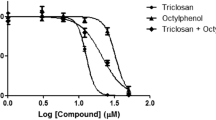Abstract
There is increasing concern about the degradation and metabolisation as well as the biochemical mechanisms of action of organometallic compounds. They are known to be immunotoxic and/or neurotoxic. Because of their different toxic capacities, the development of a reliable correlation between molecular parameters and biochemical effects, which could be helpful in risk assessment, was an aim of this study. The tested organolead and -tin compounds decrease the viability of human cells in culture in a time- and concentration-dependent manner. Parabolic QSAR1 1 The abbreviations used are: TMT, trimethyltin chloride; TET, triethyltin bromide; TPT, tripropyltin chloride; TBT, tri-n-butyltin chloride; DBT, di-n-butyltin dichloride; TEL, triethyllead chloride; DEL, diethyllead dichloride; TML, trimethyllead chloride; TPhL, triphenyllead chloride; QSAR, quantitative structure-activity relationships; TSA, total surface area; MWion, ionic molecular weight; fMLP, N-formyl-L-methionyl-L-leucyl-L-phenylalanine; fluo-3, fluo-3 free acid; fluo-3 AM, fluo-3 acetoxymethyl ester; Me2SO, dimethyl sulfoxide; PLA2, phospholipase A2 (EC 3.1.1.4); FCS, fetal calf serum; HEPES, 4-(2-hydroxy-ethyl)-1-piperazineethanesulfonic acid; EGTA, [ethylene-bis(oxyethylenenitrilo)]tetraacetic acid; [Ca2+]i, cytosolic free Ca2+ concentration models yield an adequate correlation between toxicity expressed as LC50 and structural parameters like ionic molecular weight (MWion) or total surface area (TSA). Two main chemical attributes of the organometals are probably responsible for such a parabolic relationship: the hydrophobic side chain and the polar metal atom. Furthermore, all tested organometal compounds evoke a persistent increase of the cytosolic free calcium concentration [Ca2+]i. This effect is mainly due to an influx from the extracellular space. Further results suggest that Ca2+ enters the cell via opened calcium channels. Based on the essential role of Ca2+ within cellular signalling, the perturbation of calcium homeostasis appears to be an important event in final cell killing by organometals and it is most likely that other biochemical mechanisms, e.g. activation of phospholipase A2, are possibly mediated by an increase of [Ca2+]i.
Similar content being viewed by others
Author information
Authors and Affiliations
Rights and permissions
About this article
Cite this article
Ade, T., Zaucke, F. & Krug, H.F. The structure of organometals determines cytotoxicity and alteration of calcium homeostasis in HL-60 cells. Fresenius J Anal Chem 354, 609–614 (1996). https://doi.org/10.1007/s0021663540609
Received:
Accepted:
Issue Date:
DOI: https://doi.org/10.1007/s0021663540609




